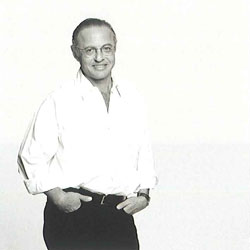Rui Sanches
 |
|
| Créditos fotográficos / Photographic credits: Abílio Leitão |
After a brief passage through Ar.Co, he pursued his education at the Goldsmiths College and Yale. One of the visible traits of his work that can be traced to his education is the Deconstructivist influence that swayed the international scene at the time. ¶ When Sanches held his first exhibition in 1984, he began what would be a long and systematic oeuvre of deconstructing Neo-Classical paintings, which he chose as his references for work. For instance, (Poussin's) Et in Arcadia Ego holds a very special place in his career and in the construction of his visual language. ¶ In the works he created throughout the 80s there is a predominance of the so-called "box games": rectangles, parallelepipeds, cubes and beacons are the shapes that seem to build up the basic structure of each piece. But as soon as that "base" is completed, the whole of the work of art suffers a process of dispossession and weightlessness. The boxes are always "hollow" and their function is mainly combinatory. The key aspect is that they form a surface modelling and direct the spectator's gaze, the elements in fact that determine the performance of the work of art. ¶ The aforementioned processes of dispossession and weightlessness are underpinned and intensified by a thorough research on curve shapes, connecting canals, waving surfaces, fluid matters, transparent bodies... elements that represent fluxes and guarantee a certain degree of inner tension and motion on the works of art. ¶ With his exhibition Body Building (1992), the author stepped away from quoting and deconstructing previously existing references. On the contrary, it was the sensuality and the physicality of human bodies that became clearer and it was his material of election, wood, that allowed the artist to make the most of elements modelled in such a way that they became suggestive of organic shapes. ¶ However, up until now one acknowledges a permanent and recurring dialectics in his work between an analytical drive and an organic penchant. The structural concern is manifested in more geometrical pieces that have as priority to establish a dialogue with architecture, with space and with the shapes of its representation. As far as the more organic pieces, they bring to the fore a choreography of violence in which the body is manifested as something excessive where geometry and representation are concerned.
http://cvc.instituto-camoes.pt/biografias-en/rui-sanches-14385-dp2.html#sigFreeIdfeb8ed9a02


